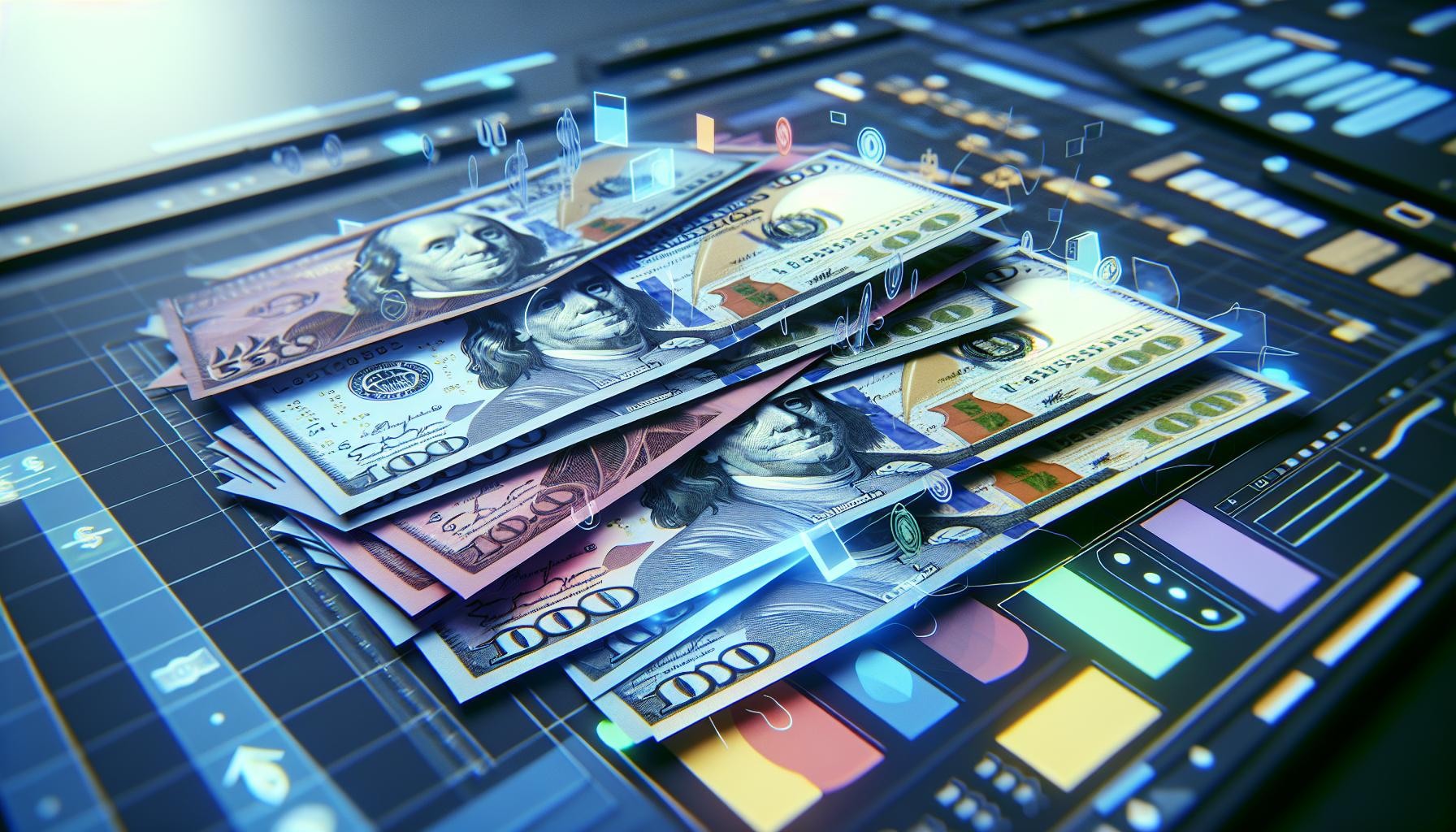Money makes the world go round, but animated money makes it spin with style! In today’s digital age, financial concepts come alive through dynamic animations that captivate audiences and simplify complex monetary ideas. From explainer videos to social media content, animated money has become an essential tool for businesses, educators, and content creators.
These eye-catching animations transform boring financial discussions into engaging visual stories. Whether it’s coins spinning through the air or dollar bills dancing across screens, animated money helps viewers understand everything from basic budgeting to complex investment strategies. It’s no wonder that major financial institutions and educational platforms have embraced this creative approach to make money matters more accessible and entertaining for everyone.
Animated:P5v2xfsmm24= Money
Animated:P5v2xfsmm24= Money combines digital animation techniques with financial imagery to create dynamic representations of currency movement financial transactions. The process involves using specialized animation software to render 2D or 3D graphics of bills coins cash flows assets moving in engaging visual sequences.
Key components of animated money include:
- Motion Graphics: Dynamic elements that showcase currency movement direction speed effects
- Visual Effects: Particle systems glows transitions that enhance the money’s appearance
- Character Animation: Anthropomorphized bills coins that express emotions tell stories
- Asset Integration: Incorporation of financial symbols charts graphs alongside animated currency
Animation techniques for money visualization:
- Frame-by-Frame: Traditional animation method creating individual frames for smooth currency movement
- Vector Animation: Scalable graphics that maintain quality across different screen sizes
- 3D Modeling: Three-dimensional currency representations with realistic textures shadows
- Motion Tracking: Technology that follows money movement through scenes
| Animation Type | Processing Time | File Size | Common Uses |
|---|---|---|---|
| 2D Vector | 2-4 hours | 5-10 MB | Social Media |
| 3D Rendered | 8-12 hours | 20-50 MB | TV Commercials |
| Motion Graphics | 4-6 hours | 10-15 MB | Educational Videos |
The technical process involves animators creating keyframes setting motion paths applying effects rendering final sequences. Digital artists use professional software like Adobe After Effects Maya Blender to generate these animations combining artistic vision with technical precision. Modern animation pipelines integrate real-time rendering artificial intelligence to streamline production enhance visual quality automatically generate money movement patterns.
Popular Uses of Animated Money in Digital Media

Animated money transforms financial content into engaging visual experiences across various digital platforms. The dynamic representation of currency creates instant visual impact and improves audience engagement in multiple contexts.
Social Media Content
Animated:P5v2xfsmm24= Money dominates social media platforms through eye-catching GIFs, short-form videos, and interactive stories. Instagram Reels, TikTok videos, and YouTube Shorts feature animated currency in financial tips, investment advice, and money management tutorials. Popular content includes:
- Falling cash animations in celebration posts
- Floating coins in cryptocurrency discussions
- Animated wallets displaying savings growth
- Money transfer visualizations in payment app promotions
- Currency conversion animations for international finance topics
Video Games and Apps
Video games incorporate animated money to enhance user experience and provide visual feedback for in-game transactions. Mobile apps leverage currency animations to create engaging financial interfaces. Key implementations include:
- Coin collection animations in mobile games
- Virtual wallet updates in banking apps
- Currency reward animations in educational games
- Transaction completion effects in payment platforms
- Money-based power-ups in arcade-style games
| Purpose | Usage Rate | User Engagement |
|---|---|---|
| Rewards | 45% | High |
| Progress | 30% | Medium |
| Feedback | 25% | Moderate |
Creating Animated Money Effects

Creating animated money effects requires specific software tools combined with proven design techniques. These elements work together to produce visually appealing financial animations that capture audience attention.
Software and Tools
Professional Animated:P5v2xfsmm24= Money software forms the foundation of creating money animations. Adobe After Effects leads the industry with its comprehensive motion graphics capabilities specifically suited for currency animations. Cinema 4D excels at creating 3D cash models with realistic textures. Blender offers a free open-source alternative with powerful particle systems for simulating falling money. Supporting tools include Adobe Photoshop for asset creation, DaVinci Resolve for compositing, and specialized plugins like Particular for particle effects.
| Software Type | Popular Options | Primary Use Case |
|---|---|---|
| 2D Animation | After Effects | Motion Graphics |
| 3D Modeling | Cinema 4D | Currency Models |
| Asset Creation | Photoshop | Texture Design |
| Compositing | DaVinci Resolve | Final Assembly |
Design Techniques
Motion tracking enables realistic money movement through 3D space. Particle systems create dynamic effects like raining cash or exploding coins. Color grading adds authenticity to digital currency representations. Key techniques include:
- Simulating physics-based paper movement for floating bills
- Adding subtle motion blur to enhance realism
- Creating seamless loops for continuous animations
- Implementing depth of field for dimensional money stacks
- Applying reflective surfaces to metallic coins
- Using particle emission for scattered bill effects
Each technique requires specific parameter adjustments in frame rate, velocity, opacity, and rotation to achieve the desired visual impact.
Best Practices for Animated Money Graphics

Creating effective Animated:P5v2xfsmm24= Money graphics requires adherence to specific visual standards while maintaining technical efficiency. These practices ensure optimal engagement across different platforms.
Style Guidelines
- Maintain realistic color schemes that match actual currency denominations
- Create smooth transitions between bills ranging from 12-24 frames per second
- Include micro-movements to simulate paper physics in bill animations
- Apply subtle shadows for depth perception at 30-40% opacity
- Implement consistent lighting angles across all animated elements
- Use scaling effects between 80-120% of original size for dynamic movement
- Add motion blur effects at 1/4 shutter speed for natural movement
- Incorporate particle effects for small denominations like coins or change
- Design with a 16:9 aspect ratio for universal platform compatibility
- Keep animations under 10 seconds for optimal viewer retention
- Export animations in H.264 codec for optimal file compression
- Maintain resolution at 1920×1080 pixels for standard HD output
- Limit file sizes to 15MB for social media compatibility
- Set keyframe density at 8-12 frames for smooth motion
- Use vector graphics for bills to ensure scalability
- Implement alpha channels for transparent backgrounds
- Optimize render settings at 2-pass minimum for quality
- Cache previews at 1/4 resolution during editing
- Apply motion paths with 30% curved handles for natural movement
- Configure anti-aliasing at 16x sampling for crisp edges
Legal Guidelines for Using Animated Currency
Federal regulations restrict the creation of realistic currency animations in digital content. The U.S. Treasury Department mandates specific requirements for depicting money in digital formats:
- Maintain one-sided representations only
- Use dimensions less than 75% or more than 150% of actual currency size
- Include “NOT LEGAL TENDER” watermark on animations
- Apply visible alterations to distinguish from real currency
Digital platforms enforce additional rules for animated money content:
- YouTube prohibits deceptive money animations promoting scams
- Instagram requires “Branded Content” tags for sponsored financial animations
- Facebook restricts animated currency in gambling-related advertisements
- TikTok monitors animated money content for misleading financial advice
Copyright considerations apply to animated currency elements:
- Original designs require proper documentation
- Stock footage licenses must cover commercial usage
- Federal Reserve seals remain protected under trademark law
- Bank logos require explicit permission for animation
| Platform | Animation Restrictions | File Requirements |
|---|---|---|
| YouTube | No scam promotion | Max 1080p resolution |
| Branded content tags | Under 100MB | |
| Limited gambling ads | 4:5 aspect ratio | |
| TikTok | Financial advice rules | Max 3 minutes |
Legal compliance extends to international markets with varying regulations:
- European Union requires fictional currency designs
- Japanese yen animations follow strict reproduction guidelines
- Canadian dollar depictions need Bank of Canada approval
- Australian regulations prohibit exact currency replicas
These guidelines protect consumers from fraudulent content while enabling creative expression in financial animations.
Animated money has revolutionized the way financial content is presented and consumed in today’s digital landscape. The combination of creative design techniques powerful software tools and strategic implementation guidelines has made it an invaluable asset for content creators and businesses alike.
While legal considerations shape the parameters of animated currency usage creators continue to find innovative ways to produce engaging financial content. By following established best practices and technical specifications animated money remains a dynamic tool that bridges the gap between complex financial concepts and audience understanding.
The future of Animated:P5v2xfsmm24= Money in digital media looks promising as technology advances and creative possibilities expand. Its ability to transform dry financial topics into visually compelling content ensures its continued relevance in our increasingly digital world.

